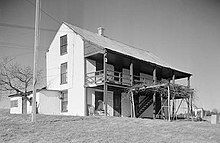Kennedy Farmhouse
Kennedy Farm | |
 The Kennedy Farmhouse, sketch published in 1902. John Brown in the chair in the yard. | |
| Location | Samples Manor, Maryland |
|---|---|
| Coordinates | 39°22′47″N 77°42′56″W / 39.37972°N 77.71556°W |
| Area | 1.77 acres (0.72 ha) |
| Built | c. 1800, 1852 |
| NRHP reference No. | 73000941 |
| Significant dates | |
| Added to NRHP | November 7, 1973[1] |
| Designated NHL | November 7, 1973[2] |

The Kennedy Farm is a
Historic significance
The Kennedy Farm is a parcel of under 2 acres (0.81 ha) of land on the west side of Chestnut Grove Road, a few miles north of Harpers Ferry, West Virginia, in a rural part of southern Washington County, Maryland. It is part of a much larger farm property that was purchased in 1852 by Dr. Robert Kennedy. Kennedy took the small log cabin on the property, and mounted it on a tall (one-story in height) stone foundation, added a frame addition to one side, and covered both with a gabled roof. Kennedy died in 1858.[4]
John Brown arrived in Maryland in 1859 and rented the house. For three months Brown and his co-conspirators lived here, pretending to be exploring mining opportunities. Supporters arrived, weapons arrived, and they planned an attack on the federal armory at Harpers Ferry in a bid to incite a slave rebellion.
Conditions at the Kennedy farmhouse, described as "flea-infested", were spartan. The men slept upstairs on the floor. Brown's daughter Anne and Martha, Oliver's wife, who were there doing cooking and serving as look-outs, until Brown sent them home to New York on September 30, slept on crudely-stuffed mattresses. The wooden crates with weapons were covered and used for seats. Brown had to buy a stove in Harpers Ferry, as Anne failed at cooking potatoes in the fireplace.[5]
On the day of
The farmhouse was searched immediately, and a trove of John's correspondence and many copies of his
Except for the engine house at the arsenal, which the raiders held for less than a day, the Kennedy Farm is the location most associated with John Brown's raid. It has been added to the National Register of Historic Places.[6]
Post-raid history


The house underwent a number of ownership changes, and significant alterations, over the next 100+ years. In 1950, the
The auditorium was rented on summer weekends by a local black entrepreneur, John Bishop, who booked into that venue dozens of the biggest stars of rhythm and blues on the Chitlin' Circuit, including Ray Charles, Aretha Franklin, James Brown, Marvin Gaye, Little Richard, Chuck Berry, B. B. King, Eartha Kitt, Otis Redding, Etta James, The Coasters, and The Drifters.[7][8]
When it was designated a National Historic Landmark in 1974, it was described as a 2+1⁄2-story house that used stone, brick and log construction with a stucco overlay. It had four bays, with a double-tiered porch running outside three rooms on the first and second floors. There were two rooms in the attic, and a small shed addition to the rear. An interior stair links the central rooms inside, and an exterior stair links the porch's two levels.[6]
The house then underwent a major restoration effort, funded by public and private sources, to return it to its 1850s appearance.[4]
See also

- List of National Historic Landmarks in Maryland
- National Register of Historic Places listings in Washington County, Maryland
References
- ^ "National Register Information System". National Register of Historic Places. National Park Service. April 15, 2008.
- ^ "Kennedy Farm". National Historic Landmark summary listing. National Park Service. Archived from the original on November 14, 2007. Retrieved June 17, 2008.
- ^ "The Kennedy Farmhouse". The Kennedy Farmhouse. Retrieved March 31, 2017.
- ^ a b "Restoration". The Kennedy Farmhouse. Retrieved March 31, 2017.
- ISBN 978-1-4798-0275-3.
- ^ a b Levy, Benjamin (June 13, 1973). "National Register of Historic Places Inventory Nomination: Kennedy Farm". National Park Service. Retrieved March 24, 2009.
- ISBN 978-0-9976772-1-8.
- newspapers.com.
External links
- Official website
- John Brown's Headquarters, Washington County, including photo in 1976, at Maryland Historical Trust
- Historic American Buildings Survey (HABS) No. MD-227, "Kennedy Farm, Chestnut Grove Road, Samples Manor vicinity, Washington County, MD", 12 photos, 8 measured drawings, 4 data pages, 1 photo caption page




